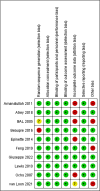Comparative postoperative prognosis of ceramic-on-ceramic and ceramic-on-polyethylene for total hip arthroplasty: an updated systematic review and meta-analysis
- PMID: 39346065
- PMCID: PMC11438439
- DOI: 10.7717/peerj.18139
Comparative postoperative prognosis of ceramic-on-ceramic and ceramic-on-polyethylene for total hip arthroplasty: an updated systematic review and meta-analysis
Abstract
Objective: To compare the clinical outcomes between ceramic-on-ceramic (CoC) and ceramic-on-polyethylene (CoP) bearing surfaces in patients undergoing total hip arthroplasty (THA) through a pooled analysis and evidence update.
Methods: We performed a systematic literature search using PubMed, Embase, Cochrane Library and Web of Science up to March 2023 for studies that compared the bearing surfaces of CoC and CoP in patients undergoing THA. The primary outcomes were the incidence of common postoperative complications and the rate of postoperative revision. The secondary outcome was the Harris Hip Score.
Results: A total of 10 eligible studies involving 1,946 patients (1.192 CoC-THA versus 906 CoP-THA) were included in the evidence synthesis. Pooled analysis showed no significant difference in the rates of common postoperative complications (dislocation, deep vein thrombosis, infection, wear debris or osteolysis) and of revision. After eliminating heterogeneity, the postoperative Harris Hip Score was higher in the CoC group than in the CoP group. However, the strength of evidence was moderate for the Harris Hip Score.
Conclusion: CoC articulations are more commonly used in younger, healthier, and more active patients. While the performance of conventional polyethylene is indeed inferior to highly cross-linked polyethylene, there is currently a lack of sufficient research comparing the outcomes between highly cross-linked polyethylene and CoC bearing surfaces. This area should be a focal point for future research, and it is hoped that more relevant articles will emerge. Given the limited number of studies included, the heterogeneity and potential bias of those included in the analysis, orthopaedic surgeons should select a THA material based on their experience and patient-specific factors, and large multicentre clinical trials with >15 years of follow-up are needed to provide more evidence on the optimal bearing surface for initial THA.
Keywords: Ceramic-on-ceramic; Ceramic-on-polyethylene; Complications; Harris hip score; Revision; Total hip arthroplasty.
©2024 Wu et al.
Conflict of interest statement
The authors declare there are no competing interests.
Figures








Similar articles
-
What Is the Frequency of Fracture of Ceramic Components in THA? Results from the Norwegian Arthroplasty Register from 1997 to 2017.Clin Orthop Relat Res. 2020 Jun;478(6):1254-1261. doi: 10.1097/CORR.0000000000001272. Clin Orthop Relat Res. 2020. PMID: 32348085 Free PMC article.
-
Comparison of cementless total hip arthroplasty survivorship between metal-on-highly cross-linked polyethylene and ceramic on ceramic bearings: A case control study with a 5-9-year follow-up.Orthop Traumatol Surg Res. 2018 Sep;104(5):663-669. doi: 10.1016/j.otsr.2018.04.016. Epub 2018 Jun 12. Orthop Traumatol Surg Res. 2018. PMID: 29902637
-
[Meta-analysis of different joint interfaces in total hip arthroplasty under long-term follow-up].Zhongguo Gu Shang. 2023 Feb 25;36(2):165-71. doi: 10.12200/j.issn.1003-0034.2023.02.014. Zhongguo Gu Shang. 2023. PMID: 36825419 Chinese.
-
Ceramic-on-Ceramic in Total Hip Replacement Revision.Z Orthop Unfall. 2018 Jun;156(3):272-280. doi: 10.1055/s-0043-124767. Epub 2018 Feb 27. Z Orthop Unfall. 2018. PMID: 29486505 English, German.
-
Ceramic on Ceramic or Ceramic-on-polyethylene for Total Hip Arthroplasty: A Systemic Review and Meta-analysis of Prospective Randomized Studies.Chin Med J (Engl). 2015 May 5;128(9):1223-31. doi: 10.4103/0366-6999.156136. Chin Med J (Engl). 2015. PMID: 25947407 Free PMC article.
References
-
- Almaawi A, Alzuhair A, AlHakbani A, Benfaris D, Al-Abdullatif F, Alabdulkarim NH, Awwad W. Comparison of ceramic-on-ceramic and ceramic-on-highly-crosslinked-polyethylene in primary total hip arthroplasty: findings of a meta-analysis. Cureus. 2021;13:e13304. doi: 10.7759/cureus.13304. - DOI - PMC - PubMed
-
- Amanatullah DF, Landa J, Strauss EJ, Garino JP, Kim SH, Di Cesare PE. Comparison of surgical outcomes and implant wear between ceramic-ceramic and ceramic-polyethylene articulations in total hip arthroplasty. The Journal of Arthroplasty. 2011;26(6 Suppl):72–77. doi: 10.1016/j.arth.2011.04.032. - DOI - PubMed
-
- Atrey A, Wolfstadt JI, Hussain N, Khoshbin A, Ward S, Shahid M, Schemitsch EH, Waddell JP. The ideal total hip replacement bearing surface in the young patient: a prospective randomized trial comparing alumina ceramic-on-ceramic with ceramic-on-conventional polyethylene: 15-year follow-up. The Journal of Arthroplasty. 2018;33:1752–1756. doi: 10.1016/j.arth.2017.11.066. - DOI - PubMed
-
- Bader R, Steinhauser E, Zimmermann S, Mittelmeier W, Scholz R, Busch R. Differences between the wear couples metal-on-polyethylene and ceramic-on-ceramic in the stability against dislocation of total hip replacement. Journal of Materials Science: Materials in Medicine. 2004;15(6):711–718. doi: 10.1023/b:jmsm.0000030214.79180.13. - DOI - PubMed
-
- Bal BS, Aleto TJ, Garino JP, Toni A, Hendricks KJ. Ceramic-on-ceramic versus ceramic-on-polyethylene bearings in total hip arthroplasty: results of a multicenter prospective randomized study and update of modern ceramic total hip trials in the USA. 10th International BIOLOX Symposium; 2005 2005 Jun 10-11; Washington, DC.2005. - PubMed
Publication types
MeSH terms
Substances
LinkOut - more resources
Full Text Sources
Medical

